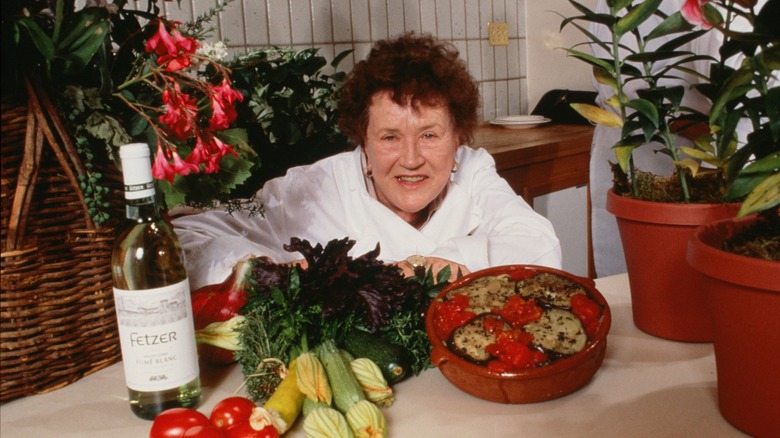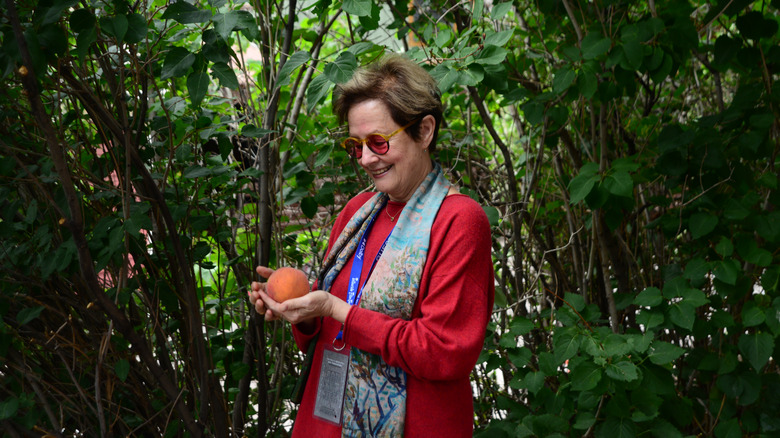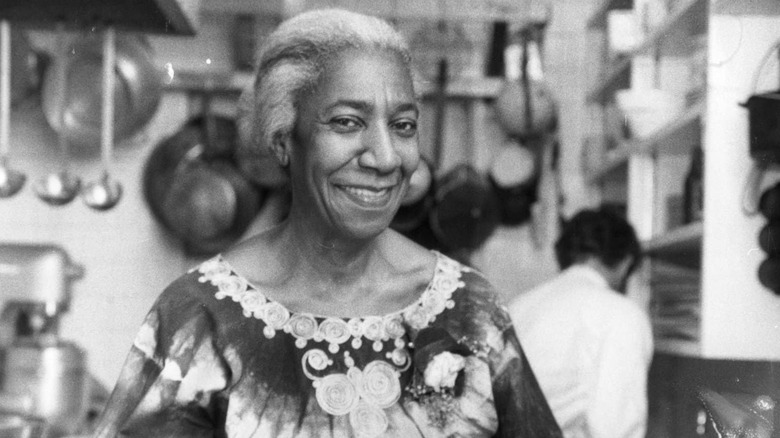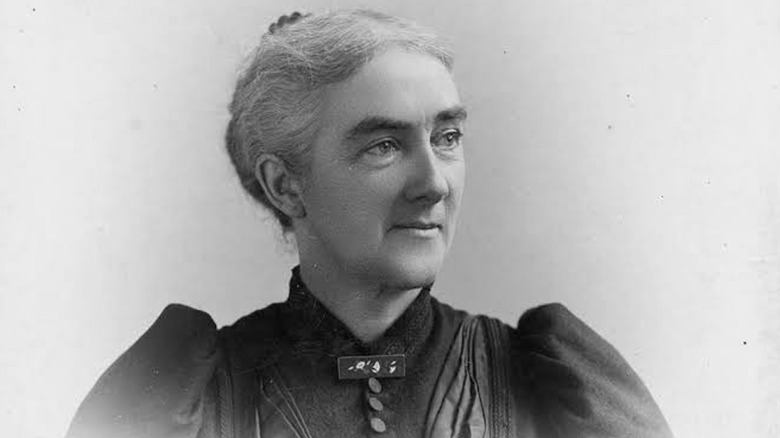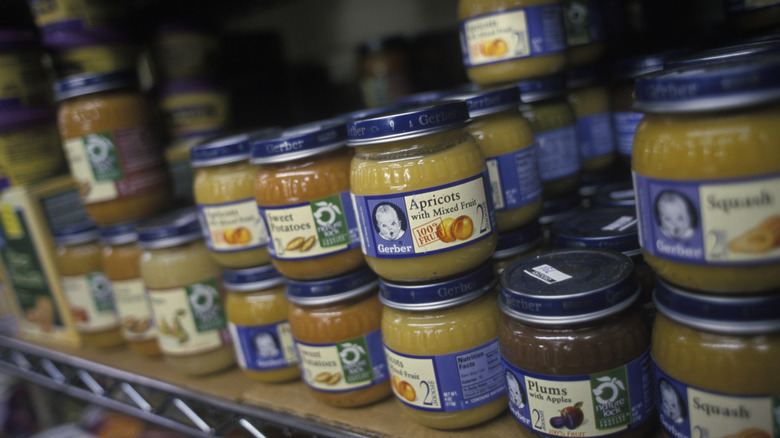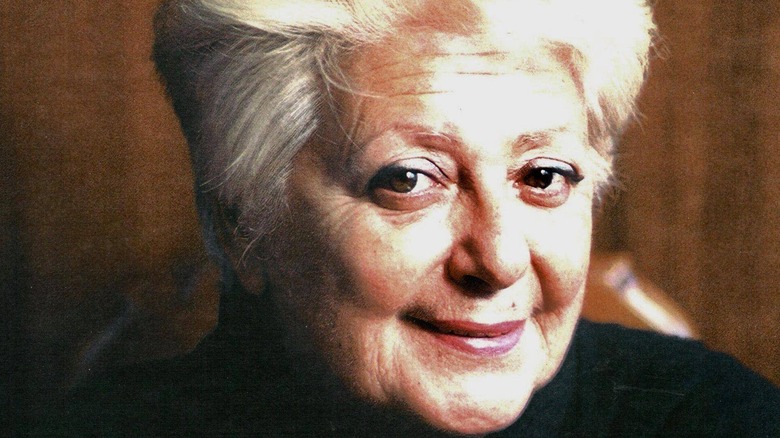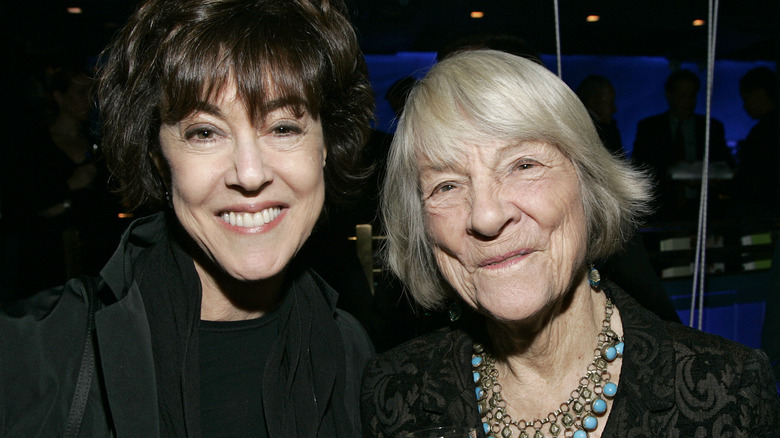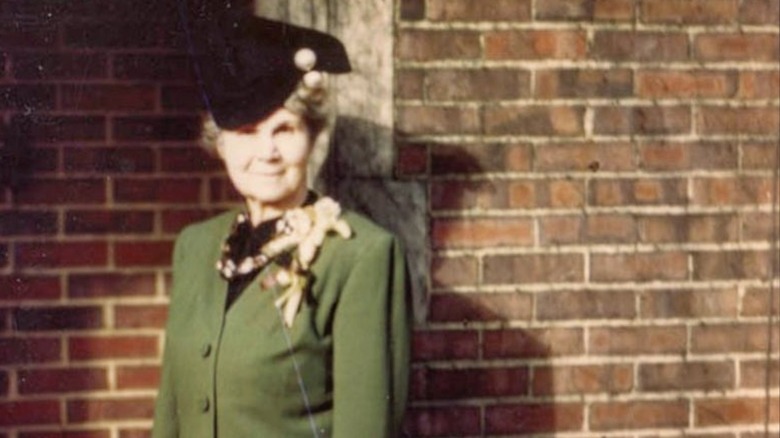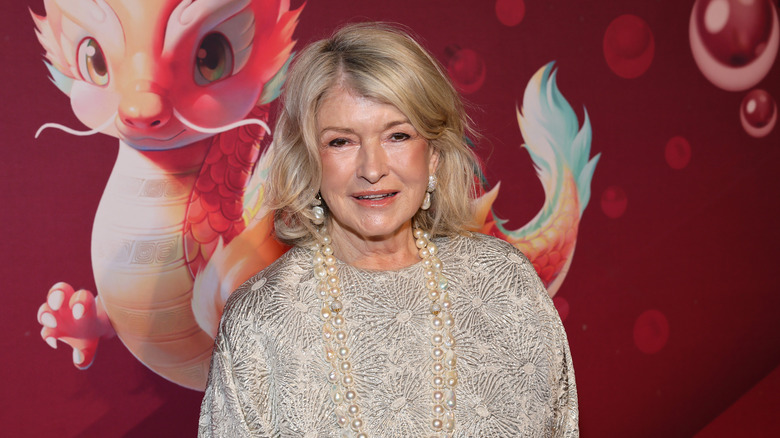15 Women Who Changed The American Food Industry For The Better
Long before they were given the credit they deserved, women have been driving education and change with many substantial contributions to food, nutrition, agriculture, and food science. Whether it has been pioneering a career in science and women's education like Ellen Swallows Richards, standing proudly in their authenticity of character and ethnicity like Edna Lewis and Madhur Jaffrey, or changing the lexicon, misperceptions, shortfalls, and habits around food, women have always played a key role in creating access to education, health, and joy.
The opportunities women and girls have access to today can be attributed to an army of brave, stubborn, intelligent women before them who refused to accept the status quo. The strength of their conviction is just as important as what came out of their kitchens. Here are just 15 women — among many others — who have influenced the American food industry for the better, inspiring a new generation of leaders, advocates, writers, cooks, and scientists in their wake.
Julia Child brought approachable French cuisine to the American public
You would be hard-pressed to find an American in the food industry who hadn't heard of Julia Child. She was, after all, one of the first women to become a household name and TV chef personality. Not only did Child bring French home cooking into the homes of Americans across the country through her TV series and cookbooks, but she also helped normalize kitchen mistakes, showing viewers in real time how to recover from them and still turn out delicious-tasting dishes. At the time, this was as revolutionary as what she was teaching the public to cook.
Child was the "first" or "only" woman in various categories, from her induction into The Culinary Institute of America's Hall of Fame to having her own popular cooking show on television. Child helped increase the public's access to French cuisine, replaceable at-home cooking techniques, and food education. She also co-founded the American Institute of Wine and Food, a non-profit dedicated to culinary and health education to support and improve individual and public health.
Alice Waters led the slow food movement, promoting local sustainable cooking
Alice Waters, proprietor of the famous Chez Panisse, is known for introducing the U.S. to the idea of farm-to-table long before its popularity. Waters began her foray into cooking habits that encouraged biodiversity and prioritized local and sustainable food sources with her groundbreaking California-based restaurant in 1971, now over 50 years ago. Her work has continually pushed against the fast-food culture that prevails in much of the U.S. food industry and schools to the detriment of the public's health. The definition of "California Cuisine," with ideas that point towards fresh foods, was first shaped by the actions of Waters.
Waters' intentions are not just cast on the present but, more importantly, for future generations. An advocate for the slow food movement and food education within the classroom, in 1995, Waters started her organization, the Edible School Yard Project, which holistically brings ideas of education, community, nutrition, food, science, and health into the classroom through land-based projects.
Waters is known for inspiring a generation of food innovators, writers, and educators, including Samin Nosrat, who in her own right has carried the work of Waters into her career.
Edna Lewis was the Godmother of Southern cooking and one of the first African American women to publish under her own name
Edna Lewis was born just after the turn of the century in a farming town in Virginia, during the era of segregation that left Lewis, who was Black, without anywhere to be educated. Instead, she learned from a tutor hired by her formerly enslaved grandfather. Lewis's exposure to book-based learning, alongside hands-on education from French-inspired cooking techniques to hunting, fishing, and foraging, provided the foundation for her later career.
Later, Lewis relocated to New York, opening Cafe Nicholson and becoming one of the only Black female chefs, praised for her French-meets-Southern-inspired food. She eventually moved on to other opportunities, including teaching in the African Hall of the Smithsonian and opening her own restaurant in New York City's Harlem.
Lewis's first cookbook, "The Edna Lewis Cookbook," was published in 1972 under her name and without an attempt to hide her gender or race. For a Black woman in the U.S. at this time, following the long period it took for The Civil Rights Act of 1964 and desegregation to become widely accepted, Lewis's boldness, transparency, and ownership of her own identity were revolutionary.
Ellen Swallow Richards was the first woman to be accepted into MIT and founded American Home Economics
While the current perception of "home economics" points to old-fashioned feminine stereotypes, that was not the case when the subject was first introduced into the classroom. Founded by Ellen Swallow Richards, the first woman to be accepted into the prestigious Massachusetts Institute of Technology at a time when over half of girls were not enrolled in education, home economics was designed to bring girls into the classroom and provide job-related training for their futures. She is also known for her significant contributions which led to safe food labeling.
After graduating with a bachelor's in chemistry from Vassar and attending the male-only MIT, Richards was interested in public health and women's education. She understood that there weren't many paid opportunities for women in the sciences. By devising a structure that focused on women and "home science," Richards, along with others like Margaret Murray, hoped to be able to help translate knowledge into the current offerings and applicable opportunities, even if only to give women the opportunity to spend less time on chores and more time pursuing their interests outside the home. These home economic classes and programs later became the backbone for the nation's much-needed subsidized school lunch programs, helping to support children from a variety of economic backgrounds to have access to education.
Dorothy Gerber innovated how America fed their young with Gerber Baby Food
Dorothy Gerber and her husband paved the way for the world of today's pre-made baby foods. In 1928, following Gerber's foray into the food-straining world of baby weaning, she, like many other mothers at the time, was tired of being chained to her kitchen to execute the laborious task of feeding her seven-month-old daughter. Thanks to Dorothy's insights and motivation, the clear gap in the market, and her husband's canning business, Gerber Baby Food was born. Their company did the cooking and straining for consumers in advance, tapping into a massive potential market of overworked parents.
Now owned by food giant Nestlé, the literal and figurative face of Gerber Baby has changed several times over the years. At one point in the late 1980s, the company offered new parents a baby-feeding hotline to answer any nutritional questions. Today, the company is just one of many offering a wide range of first foods, toddler-age snacks, and advice within the marketplace. But it all started with Dorothy, her husband, their daughter, and the desire to make life easier for parents and children.
Bewei Yang Chao helped change America's perception of Chinese cuisine
Thanks to the work of Bewei Yang Chao (or Chao Yang Bewei, using the Chinese structure of family name first) and other seminal influences, Americans now benefit from our access to various Chinese dishes, cooking, and eating practices enjoyed regularly. If you've ever turned to the quick fix of a homemade stir-fry on a busy weeknight, you have Chao to thank.
Chao first used the term stir-fry in her book "How to Cook and Eat in Chinese," published in 1945. Chao, a doctor who had immigrated to the U.S., first to Massachusetts and then to Berkeley from Nanjing, China, helped redefine Chinese home cooking in the U.S. despite her public-facing profile fading a few years after her cookbook publication.
In her book, Chao broke down quintessential Chinese wok cooking techniques. Her term "stir-fry" replaced the Mandarin word ch'ao, which referred to the high heat and continual circulation of ingredients. Chao used the term "stir-fry," as the literal translation was impossible. Initially used only as a verb, "stir-fry" has also come to be defined as a noun, referring to a dish made quickly through ch'ao. Not only did Chao bring these Chinese cooking techniques into the U.S. vocabulary, but she did so in a way that reflected her upbringing and culture, rather than assimilating her cooking style to slip into mainstream American culture without a splash.
Samin Nosrat brought us back to basics with salt, fat, acid, and heat
Much has been written about Nosrat's joyful and inquisitive approach to food, and rightfully so. At a time when the fad for perfectly curated dinner parties, "clean eating," and molecular gastronomy still had its grip on the American public, Nosrat's approach was like a breath of fresh air, a relaxing of the shoulders and a beckoning into understanding the foundations of what makes food taste so good.
Nosrat's tenacity earned her a pedigree hands-on education, first with Alice Waters, and later with Michael Pollan. Nosrat's "Salt, Fat, Acid, Heat" cookbook, with illustrations by the remarkable Wendy MacNaughton, showcases the science behind pleasurable food. Her accompanying Netflix series reflects Nosrat's warm, excitable personality, reminding the American public of the heritage and technical aspects behind what we eat and the joys of cooking with others.
Though her cookbook does contain several delicious, approachable recipes in its second half, part of Nosrat's mission has been to give home cooks the confidence to master the science behind the recipes, and the freedom to use recipes as guides rather than hard and fast rules.
Marcella Hazan changed the way Americans cooked Italian cuisine
If you've ever made the gloriously simple-yet-flavorful tomato sauce that requires just three ingredients — tomatoes, butter, and onion — you have the late Marcella Hazan to thank for your dinner. Hazan left her well-seasoned mark on many home cooks across the U.S. and U.K. and helped improve the perception of Italian home cooking.
Thanks to the discerning eyes of Judith Jones, Marcella released her first of many cookbooks, including "The Classic Italian Cook Book" and "The Second Classic Italian Cookbook" in the early 1970s, which were eventually combined into one Italian cooking bible. Hazan's cooking subscribed to a style often referenced within Italian cuisine: simplicity reigns supreme.
Hazan relocated to the U.S. from her home in Italy in 1955 alongside her American-born food writer husband. Initially trained as a biologist, her move highlighted the necessity of adapting American ingredients to suit her Italian upbringing and cooking style, which often relied on fresh ingredients with simple but thoughtful preparations. As she began this investigation, serendipity had her teaching a small group of women how to make ingredient-led Italian home cooking, bucking the prepackaged and convenience food trends of the era. From there, her journey into cooking and teaching took root, changing how many think about Italian cuisine for the better.
Deb Perelman's Smitten Kitchen blog changed the way the American public accessed recipes and ideas about food
In 2006, the world of online recipes and content was an entirely different place than it is today. At the time, there were just a handful of successful and reliable blogs that readers could turn to for ideas, inspiration, and recipes that worked. Deb Perelman's Smitten Kitchen was one such site. Through her weekly newsletters and paywall-free website, Perelman helped pave the way for a new generation of online food content, recipes, personalities, writers, and bloggers to step forward.
Perelman, now a three-time author and New York Times bestseller, is a self-taught chef focusing on food in a family setting without subscribing to the stereotype of the perfect mother or hostess. She frequently discusses her small workspace, limited time, and the reality of a messy kitchen and busy life outside the kitchen. Her work became relevant to an entire audience of people who were often made to feel less than when it came to the dinner table. It makes sense that Perelman was the recipient of the IACP Julia Child Award, both women known for their authenticity and sense of self.
Perelman's success has also helped to usher others in the food blogging era, providing reciprocal accessibility both for individuals looking to develop their work and those looking for resources on how to improve their cooking at home.
Judith Jones introduced us to some of the greatest food writers of our time
Editors can play a massive role in shaping the culture of food. We only need to turn to Judith Jones' work to see this statement's validity. As an editor for Knopf, Jones first published the work of Julia Child, Marcella Hazan, Claudia Roden, Madher Jaffrey, Edna Lewis, and so many others. She was known for her distinctive interest in women, often from marginalized backgrounds or with niche subject areas of interest, who were frequently gate-kept out of the publishing world. Jones helped pave the way for the future of food culture in America by creating access both for writers and for cooks, focusing specifically on regional cooking. We have her to thank for setting the standard of variety now found in the American publishing industry. (We also have her to thank for "The Diary of Anne Frank," which Jones rescued from the reject pile.)
Not just an editor, Jones also wrote cookbooks herself, beginning with her first co-authored book, "The L.L. Bean Game and Fish Cookbook," published in 1983. Other authored books included "The Pleasures of Cooking for One," a personal exercise in creating joy following the death of her husband. Though Jones passed away in 2017 at the age of 93 years old, her work has changed the face of the cookbook world for the better.
Irma Rombaeur pioneered the world of self-publishing
Irma Rombauer's self-published cookbook, "The Joy of Cooking," remains one of the most well-read cookbooks, referenced by some of the U.S.'s most influential food celebrities, including Martha Stewart. Published just as the Great Depression began, the book, comprising over 400 recipes, outlines just about everything, including home entertaining, menu planning, and how to successfully grocery shop and ration for wartimes. It has since been republished multiple times, with sections added and replaced, no longer needing such chapters as wartime food rationing tips. Retracing each print would be a study of the country's recent history.
Rombauer created the book alongside her daughter Marion, who would test her mother's recipes. Eventually, the book's safekeeping was passed down to Marion. The book's revision and stewardship continue to be passed down through the family. To have been so bold as to self-publish at that time was a remarkable feat. To have done so successfully is beyond measure, and Rombauer paved the way for future self-published authors.
Mollie Katzen was among the first to popularize vegetarian cooking in the American mainstream
Long before "meatless Mondays" or "plant-based eating" became recognizable phrases among the American public, author and cook Mollie Kaizen introduced the American people to vegetable-based recipes and dishes. Her groundbreaking bestseller "Moosewood Cookbook" was first self-published in the early 1970s, before being later picked up by publishers. The book worked to bring the idea of meat-free and vegetable-forward cooking into the spotlight. As her work has developed, Katzen has also reminded the public that the descriptor "vegetarian" more often focuses on the person consuming the food rather than the food itself. She wants it to refer to what is on the plate, which should be inviting to all kinds of eaters.
Katzen's first book helped to bridge the divide at the time between healthy eating and pleasurable eating. At the time, most plant-forward efforts fell under the term "hippie food," the often raw, under-seasoned, or bland macrobiotic eating of the 1960s that came with health benefits but at the perceived cost of pleasure. Katzen's approach worked to defy this binary, using spices and dairy to improve flavor without meat. This thinking challenged the norm then and helped pave the way for other plant-forward cooks and writers.
Madhur Jaffrey introduced Indian and South Asian cuisines to Western audiences
Just over 50 years ago, Madhur Jaffrey published the cookbook, "An Invitation to Indian Cooking," which is given credit for helping to put Indian cuisine on tables around the world, including the U.S. and the U.K. The book launched Jaffrey's second career — she has since added another 29 to accompany it.
Jaffrey was born in 1933, in Delhi, India, before the British-enforced Partition. She eventually moved to London to study drama, leading to her first successful career as an actress, and New York with her then-husband. A serendipitous meeting with a New York Times food critic helped boost Jaffrey into the spotlight, giving her the clout she needed to publish her first cookbook with the support of Judith Jones. From then, Jaffrey spent her career helping to broaden the understanding of Indian home cooking, from the number of spices that went into various curries (more than just curry powder) to the vast array of regional cuisine throughout India and the difference between "spicy" and packing a good amount of "heat."
Her warm approach and remarkable storytelling ability, alongside her insight and depth of knowledge, have opened up the world of Indian cuisine to those who may have never stepped foot in the country itself. In 2022, she was awarded the Parma Bhushan for cultural ambassadorship, one of India's most prestigious civilian honors.
Michelle Obama helped reframe America's food policies and promote access to better health
It's safe to say no matter which side of the political aisle you choose to sit on, we can acknowledge the positive changes from the former first lady and self-appointed "mom-in-chief" across many aspects of institutionalized food. Her focus while first lady was mainly on the next generation of leaders, inspired by her daughters.
From symbolic and more public-facing changes like planting the White House's first kitchen garden and her Let's Move campaign, the Obamas were also doing less public-facing work, which led to significant policy changes. In 2010, the Healthy, Hunger-Free Kids Act helped to reform school lunches, adding vegetable and fruit options and reducing the amount of sodium as standard. Subsequently, restrictions on appropriate options stocked in school vending machines were scrutinized. Some schools were able to extend their free or subsidized meal offerings to include breakfast and lunch. And who can forget the food-focused television show "Waffles and Mochi" produced by the Obamas that featured prominent chefs and food educators from around the globe? For that and so much more, we can say, "Thanks, Obama."
Martha Stewart changed the face of dinner parties and home entertaining
Hardworking and driven even in her childhood, Martha Stewart became a household name, synonymous with her meticulous attention to detail in her efforts to elevate the art of home entertainment. Her entertaining enterprise, with humble beginnings as a catering business in her basement, was actually her third successful career, following a stint as a model and then as a stockbroker.
Stewart wrote a host of books about entertaining and home decorating, leaving virtually no stone unturned and detailing each subject flawlessly. Her drive and success created television series, houseware lines, and magazines, including several published under her own brand, eventually combined into one that ruled them all, Martha Steward Living Omnimedia. Stewart significantly influenced home entertaining with everything she touched, showcasing her business skills alongside her knack for details, decor, and entertaining. Her brand has dramatically influenced the industry, showcasing her resilience after being forced to rebuild following a prison sentence for conspiracy and obstruction of justice related to a stock fraud case. It's hard to think of a corner of today's lifestyle market that Martha Stewart has not touched.

